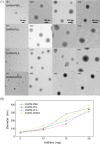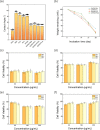Biodegradable polyester copolymers: synthesis based on the Biginelli reaction, characterization, and evaluation of their application properties
- PMID: 38813120
- PMCID: PMC11135155
- DOI: 10.1039/d4ra02002b
Biodegradable polyester copolymers: synthesis based on the Biginelli reaction, characterization, and evaluation of their application properties
Abstract
The Biginelli reaction, a three-component cyclocondensation reaction, is an important member of the multicomponent reaction (MCR) family. In this study, we conducted end-group modifications on a variety of biodegradable polyesters, including poly(1,4-butylene adipate) (PBA), poly(ε-caprolactone) (PCL), polylactic acid (PLA), and poly(p-dioxanone) (PPDO), based on the precursor polyethylene glycol (PEG). By combining two polymers through the Biginelli multi-component reaction, four new biodegradable polyester copolymers, namely DHPM-PBA, DHPM-PCL, DHPM-PLA, and DHPM-PPDO, were formed. These Biginelli reactions demonstrated exceptional completeness, validating the efficiency of the synthesis strategy. Although the introduction of various polyesters lead to different properties, such as crystallinity and cytotoxicity, the newly synthesized 3,4-dihydro-2(H)-pyrimidinone compounds (DHPMs) exhibit enhanced hydrophilicity and can self-assemble in water and N,N-dimethylformamide (DMF) solution to form micelles with a controllable size. Furthermore, DHPM-PPDO promotes cellular growth and has potential applications in wound healing and tissue engineering. In conclusion, this method demonstrates great universality and methodological significance and offers insights into the medical applications of polyethylene glycol.
This journal is © The Royal Society of Chemistry.
Conflict of interest statement
There are no conflicts to declare.
Figures




Similar articles
-
Characterization of the thermo- and pH-responsive assembly of triblock copolymers based on poly(ethylene glycol) and functionalized poly(ε-caprolactone).Acta Biomater. 2011 Oct;7(10):3708-18. doi: 10.1016/j.actbio.2011.05.035. Epub 2011 Jun 6. Acta Biomater. 2011. PMID: 21672641
-
Amphiphilic toothbrushlike copolymers based on poly(ethylene glycol) and poly(epsilon-caprolactone) as drug carriers with enhanced properties.Biomacromolecules. 2010 May 10;11(5):1331-8. doi: 10.1021/bm100116g. Biomacromolecules. 2010. PMID: 20405912
-
Fine tuning micellar core-forming block of poly(ethylene glycol)-block-poly(ε-caprolactone) amphiphilic copolymers based on chemical modification for the solubilization and delivery of doxorubicin.Biomacromolecules. 2011 Jul 11;12(7):2562-72. doi: 10.1021/bm200375x. Epub 2011 Jun 6. Biomacromolecules. 2011. PMID: 21598958
-
Biodegradable poly(epsilon-caprolactone)-poly(ethylene glycol) copolymers as drug delivery system.Int J Pharm. 2009 Oct 20;381(1):1-18. doi: 10.1016/j.ijpharm.2009.07.033. Epub 2009 Aug 5. Int J Pharm. 2009. PMID: 19664700 Review.
-
Microbial degradation of aliphatic and aliphatic-aromatic co-polyesters.Appl Microbiol Biotechnol. 2014 Apr;98(8):3437-47. doi: 10.1007/s00253-014-5558-1. Epub 2014 Feb 13. Appl Microbiol Biotechnol. 2014. PMID: 24522729 Review.
References
LinkOut - more resources
Full Text Sources

